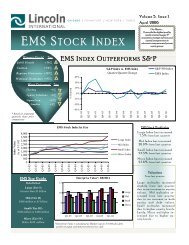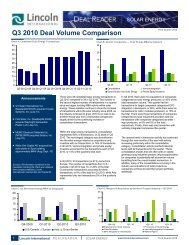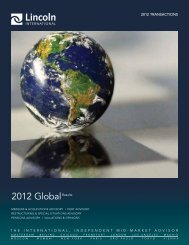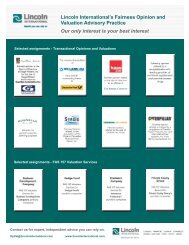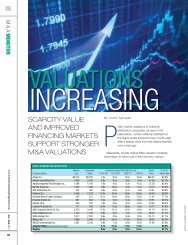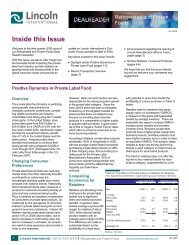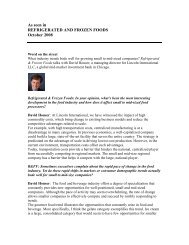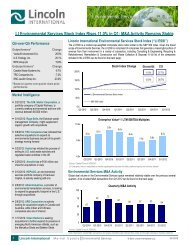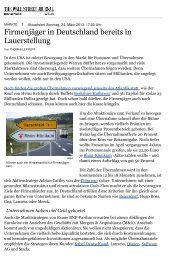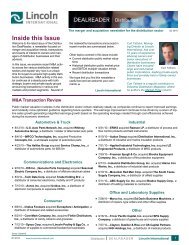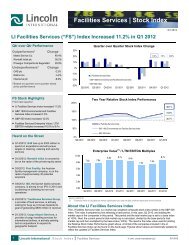Spotlight Interview: Dr. Gerhard Prante, Advisory Board Member ...
Spotlight Interview: Dr. Gerhard Prante, Advisory Board Member ...
Spotlight Interview: Dr. Gerhard Prante, Advisory Board Member ...
You also want an ePaper? Increase the reach of your titles
YUMPU automatically turns print PDFs into web optimized ePapers that Google loves.
<strong>Spotlight</strong> <strong>Interview</strong>: <strong>Dr</strong>. <strong>Gerhard</strong> <strong>Prante</strong>, <strong>Advisory</strong><br />
<strong>Board</strong> <strong>Member</strong>, Lincoln International<br />
<strong>Dr</strong>. <strong>Gerhard</strong> <strong>Prante</strong><br />
joined the advisory<br />
board of Lincoln International<br />
Germany in<br />
2003. <strong>Dr</strong>. <strong>Prante</strong> was<br />
previously CEO of<br />
AgrEvo, a Joint Venture<br />
between Hoechst<br />
and Schering, and<br />
Deputy CEO of<br />
Aventis CropScience, which was formed<br />
through the merger of AgrEvo and Rhône-<br />
Poulenc Agro. During his time at Aventis<br />
CropScience he was responsible for the<br />
sale of the company to Bayer AG for a consideration<br />
of Euro 6.9bn. Today, Bayer<br />
CropScience generates revenues of Euro<br />
5.9bn and realizes an EBITDA-margin of<br />
22%.<br />
What do you think are the overweighing<br />
trends in the Agrochem and Crop-<br />
Science industry?<br />
The global market for chemical crop protection<br />
products is today the most significant<br />
part of the crop science market with a total<br />
value of approximately $50 billion. Over the<br />
last ten years, biotechnology has been the<br />
catalyst for the development of this market.<br />
New traits in crops such as soybean, corn,<br />
cotton and oil seed rape/canola, have had<br />
a significant influence on the chemical crop<br />
protection market. Glyphosate for example,<br />
can be used today as a selective herbicide<br />
in soybeans due to the genetically induced<br />
tolerance. The herbicide tolerance trait is<br />
also available in cotton, corn and canola. In<br />
the first two a genetically induced insect<br />
resistance trait is available in biotech varieties<br />
as well.<br />
What consequences do you see deriving<br />
from these trends?<br />
These biotech crops have already and will<br />
continue to have an influence on the herbicides<br />
used by the farmers, which will hence<br />
lead to a change of portfolio in the herbicide<br />
market. The insect resistance in cotton and<br />
corn partly substitutes the use of chemical<br />
insecticides. In 2005, biotech crops were<br />
“The biotech crops and in particular<br />
the crop protection input traits will<br />
continue to grow at a rate of 8% to<br />
10% p.a. over the next ten years.”<br />
planted on approx. 90 million hectares<br />
globally. The result of the acreage growth<br />
of the biotech crops during the last 10<br />
years has been more or less stagnating<br />
chemical crop protection consumption. The<br />
biotech crops and in particular the crop<br />
protection input traits will continue to grow<br />
at a rate of 8% to 10% p.a. over the next<br />
ten years. For those market participants<br />
with a primary focus on the chemical crop<br />
protection portfolio, R&D and cost efficiency<br />
will be decisive for their competitive<br />
position and growth potential. Generic companies<br />
on the other hand will potentially<br />
enjoy more growth in the future because a<br />
number of products that recently came off<br />
patent have very high technology standards,<br />
which cannot easily be surpassed<br />
by new molecules with the same economical<br />
value for the customers.<br />
Monsanto just recently announced earnings<br />
of $334 million for Q3/06 compared<br />
to $47 million for the same period of last<br />
fiscal year. Were you surprised by this<br />
significant increase in earnings?<br />
No, this did not come as a big surprise to<br />
me. The reason is that Monsanto undertook<br />
major acquisitions in 2004 and 2005,<br />
e.g. the global market leader in vegetable<br />
seeds, Seminis, Inc. Moreover, Monsanto<br />
is the unrivalled market leader in biotech<br />
crops. Biotech crops offer two income<br />
streams, one based on the traits and the<br />
second based on the performance of the<br />
genetics. Monsanto is now harvesting the<br />
result of some twenty years of consequent<br />
investment in biotech and genetics. As<br />
mentioned earlier, biotechnology is the<br />
catalyst in forming the plant science industry.<br />
This industry has three innovation platforms,<br />
namely chemistry, biotechnology<br />
and plant genetics. The driver for innovation<br />
in this industry today is plant genetics,<br />
which employs the results of biotechnology<br />
in its breeding process.<br />
What needs do you see for plant science<br />
companies in terms of external<br />
growth opportunities?<br />
The reality of today is the existence of an<br />
approx. $50 billion crop science market.<br />
Hence the R&D-based companies will only<br />
have the chance to participate in the growth<br />
driven by the crop protection input traits<br />
and the genetics if they have the assets<br />
and the abilities to use all three innovation<br />
platforms for new innovative products for<br />
the farming industry. On the other hand,<br />
those companies with a focus on chemical<br />
crop protection products can only generate<br />
growth if they have a very strong R&D pipeline<br />
and at the same time are very cost<br />
efficient. As a result we can expect further<br />
consolidation among R&D-based companies<br />
and further acquisition activities of the<br />
generic companies. Likewise, further consolidation<br />
in the biotech as well as the seed<br />
industry will occur. One recent example is<br />
the acquisition of CropDesign by BASF and<br />
the seed acquisitions of Syngenta and<br />
Monsanto during the past 24 months.<br />
<strong>Dr</strong>. <strong>Prante</strong>, you joined Lincoln International’s<br />
<strong>Advisory</strong> <strong>Board</strong> in Germany in<br />
2003. What makes this activity interesting<br />
for you?<br />
I spent all my professional life in the chemicals<br />
and agricultural industry, including crop<br />
protection, animal health, biotech and<br />
seeds. During my time as CEO of AgrEvo<br />
and deputy CEO of Aventis CropScience, I<br />
worked together with investment banks in a<br />
number of M&A-Transactions. Thus, I believe<br />
I have a good understanding for what<br />
clients expect from their advisors. I always<br />
had a preference for those advisors who<br />
have a solid understanding of my industry<br />
based on practical experience. The prospect<br />
of working with a dynamic team of<br />
excellent M&A bankers at Lincoln International,<br />
combining senior operational experience<br />
and industry knowledge with outstanding<br />
transaction know-how, is an exceptionally<br />
attractive one.<br />
4 Lincoln International DEALREADER Chemicals Q2 2006



